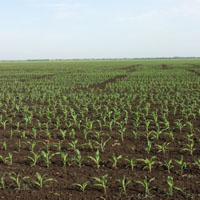Seed priming with zinc improves field performance of maize hybrids grown on calcareous chernozem

Accepted: 18 April 2021
PDF: 572
All claims expressed in this article are solely those of the authors and do not necessarily represent those of their affiliated organizations, or those of the publisher, the editors and the reviewers. Any product that may be evaluated in this article or claim that may be made by its manufacturer is not guaranteed or endorsed by the publisher.
Delivery of micronutrients to plants through seed priming improves seedling vigour and increases crops yields. Two-year filed trial was conducted in PanÄevo, Serbia, with aim to study the effect of seed priming with zinc (Zn) on field performance of three maize hybrids on calcareous chernozem deficient in plant available Zn. Seed priming treatments were: control (without priming), water priming and priming with 4 mM zinc sulphate water solution. Seed priming had significant effect on early plant growth, plant height, yield components, grain yield and grain Zn concentration. Zn-priming promoted plant growth and increased final plant height. Across two growing seasons with contrasting precipitation and three tested maize hybrids, Zn-priming resulted in an average increase of grain yield by about 18% compared to control, and by about 8.4% compared to water priming. A significant relationship between plant growth parameters, grain yield components and grain yield was detected. Grain Zn concentration was increased by Zn-priming in two hybrids in the season with less precipitation and in one hybrid in the second season. The results imply that using the seeds with elevated Zn content can improve overall field performance of maize grown on calcareous chernozem.
Highlights
- Seed priming with Zn resulted in an average increase of maize grain yield by about 18% compared to control, and by about 8.4% compared to water priming.
- Zn-priming promoted plant growth and increased final plant height of three maize hybrids.
- Overall experiment plant growth parameters were correlated with grain yield components and grain yield.
- Overall effect of seed priming on grain Zn concentration was significant, but it was increased by Zn-priming in two hybrids.
- Using the seeds with elevated Zn content can improve overall field performance of maize grown on calcareous chernozem.
How to Cite

This work is licensed under a Creative Commons Attribution-NonCommercial 4.0 International License.
PAGEPress has chosen to apply the Creative Commons Attribution NonCommercial 4.0 International License (CC BY-NC 4.0) to all manuscripts to be published.

 https://doi.org/10.4081/ija.2021.1795
https://doi.org/10.4081/ija.2021.1795



